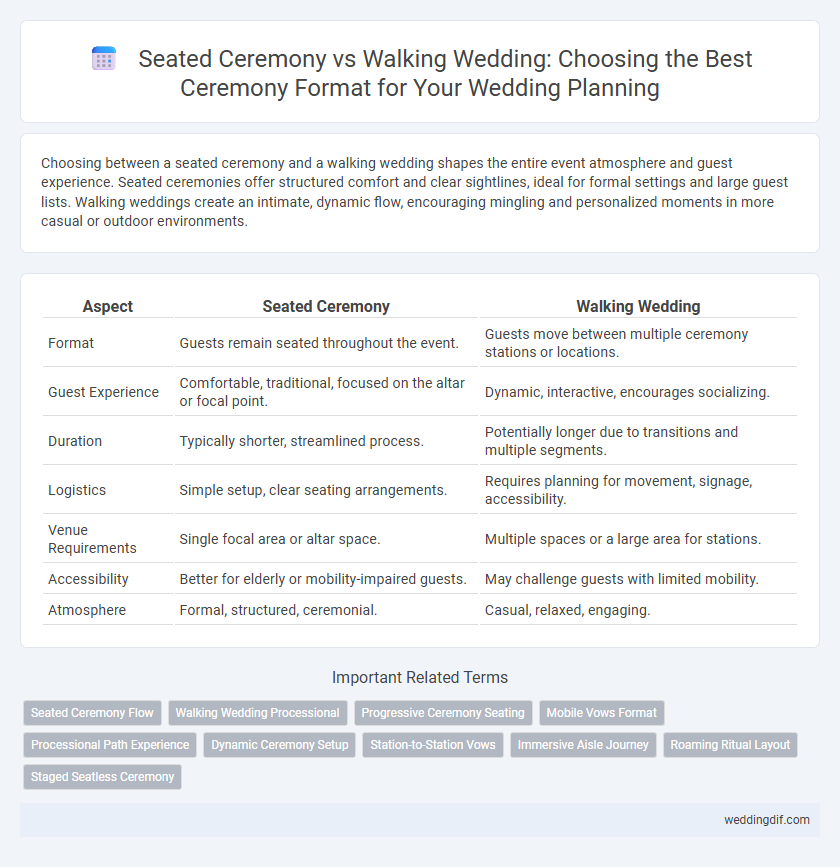Choosing between a seated ceremony and a walking wedding shapes the entire event atmosphere and guest experience. Seated ceremonies offer structured comfort and clear sightlines, ideal for formal settings and large guest lists. Walking weddings create an intimate, dynamic flow, encouraging mingling and personalized moments in more casual or outdoor environments.
Table of Comparison
| Aspect | Seated Ceremony | Walking Wedding |
|---|---|---|
| Format | Guests remain seated throughout the event. | Guests move between multiple ceremony stations or locations. |
| Guest Experience | Comfortable, traditional, focused on the altar or focal point. | Dynamic, interactive, encourages socializing. |
| Duration | Typically shorter, streamlined process. | Potentially longer due to transitions and multiple segments. |
| Logistics | Simple setup, clear seating arrangements. | Requires planning for movement, signage, accessibility. |
| Venue Requirements | Single focal area or altar space. | Multiple spaces or a large area for stations. |
| Accessibility | Better for elderly or mobility-impaired guests. | May challenge guests with limited mobility. |
| Atmosphere | Formal, structured, ceremonial. | Casual, relaxed, engaging. |
Understanding Seated Ceremonies
Seated ceremonies provide a structured environment where guests remain stationary, promoting clear sightlines and focused attention on the couple. This format enhances guest comfort, especially during longer ceremonies, and allows for organized rituals or performances to unfold seamlessly. Understanding the logistics of seating arrangements and venue layout is crucial for maximizing engagement and maintaining an intimate atmosphere.
What Is a Walking Wedding Ceremony?
A walking wedding ceremony involves guests moving together between multiple locations, creating an interactive and dynamic experience that allows couples to showcase various meaningful spots. Unlike a seated ceremony where attendees remain stationary, a walking ceremony encourages exploration and engagement throughout the event. This format is ideal for outdoor weddings or venues with scenic pathways, offering a personalized and memorable celebration.
Key Differences Between Seated and Walking Formats
Seated ceremonies provide a structured environment where guests have assigned seats, promoting clear sightlines and focused attention on the couple, which suits traditional or formal weddings. Walking weddings offer a dynamic and interactive experience, allowing guests to move freely between different stations or settings, enhancing social interaction and engagement. Key differences involve guest mobility, pacing, and atmosphere, with seated ceremonies emphasizing order and rituals, while walking weddings foster spontaneity and mingling.
Pros of a Seated Wedding Ceremony
A seated wedding ceremony offers structured comfort, allowing guests to fully focus on the vows and rituals without distraction. It creates an intimate atmosphere where every attendee has a clear view, enhancing the emotional connection throughout the event. This format simplifies logistics, making it easier to manage timing and transitions during the ceremony.
Benefits of a Walking Wedding Ceremony
A walking wedding ceremony offers a dynamic and engaging experience that encourages guest interaction and showcases multiple scenic locations, creating unique photo opportunities. This format often allows for a more relaxed and informal atmosphere, enhancing comfort and guest enjoyment throughout the event. Walking ceremonies can maximize venue versatility and provide a memorable, personalized celebration that breaks traditional seating constraints.
Guest Experience: Seated vs Walking Wedding
Seated ceremonies offer guests comfort and a clear view, enhancing engagement with the vows and allowing for a structured, intimate atmosphere. Walking weddings encourage social interaction and movement, providing a dynamic and informal experience where guests can mingle and explore different aspects of the celebration. Both formats impact guest experience by balancing comfort and interactivity, depending on the desired vibe and space constraints of the venue.
Logistics and Setup: What to Consider
Seated ceremonies require organized seating arrangements with clear aisle access and consistent guest visibility, demanding careful planning of chair layout and space allocation. Walking weddings involve a mobile flow of guests between multiple locations, necessitating clear signage, accessible pathways, and coordinated timing to ensure smooth transitions. Both formats require considerations for weather, sound systems, and guest comfort to optimize the ceremony experience.
Best Venues for Each Ceremony Format
Seated ceremonies thrive in elegant indoor venues such as grand ballrooms, historic mansions, and luxurious hotels, offering structured seating and a formal ambiance that enhances guest comfort and ceremony flow. Walking weddings suit expansive outdoor locations like botanical gardens, vineyards, and scenic parks, enabling a dynamic experience where guests move through different settings, creating intimacy and natural engagement. Selecting a venue that complements the ceremony format ensures optimal logistics, guest enjoyment, and memorable photographic opportunities.
Choosing the Right Format for Your Wedding Style
Selecting the ideal ceremony format hinges on your wedding style, with a seated ceremony offering structured elegance and formal guest experience, while a walking wedding promotes a fluid, interactive atmosphere that encourages guest mingling. Consider venue layout, guest count, and desired intimacy level to determine whether traditional rows or a dynamic procession better suits your vision. Prioritize comfort and the flow of your event to create a meaningful and memorable celebration tailored to your unique preferences.
Frequently Asked Questions on Ceremony Formats
Choosing between a seated ceremony and a walking wedding often depends on guest comfort and venue layout, with seated ceremonies providing structure and ease of viewing, while walking weddings encourage movement and interaction. Frequently asked questions include inquiries about the duration of each format, accommodation for elderly or disabled guests, and how each style affects the flow of the event. Couples commonly ask if a walking ceremony can maintain formality or if a seated arrangement allows for more personalized rituals during the ceremony.
Seated Ceremony vs Walking Wedding for ceremony format. Infographic

 weddingdif.com
weddingdif.com